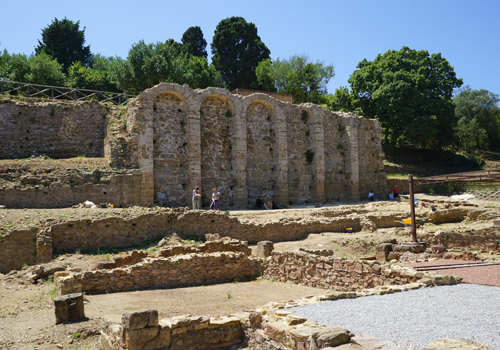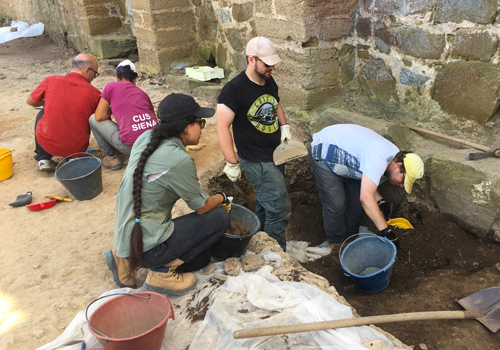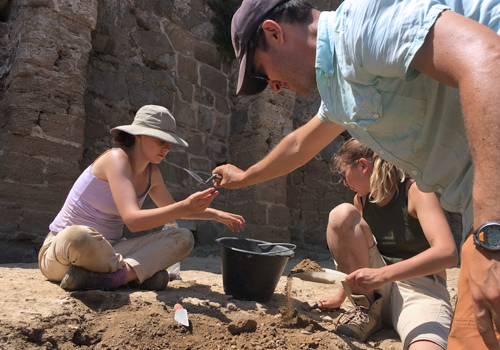Nestled on the Tuscan coast in central Italy, the ruins of the ancient city of Populonia attract tourists and archaeologists alike, offering fascinating insights into two powerful ancient Italian civilizations – the Etruscans and the Romans.
For four U of T undergraduate and graduate students, the ruins – now part of the Archaeological Park of Baratti and Populonia near modern Piombino – were their classroom for the summer, where they gained archaeological field experience under the supervision of Assistant Professor Seth Bernard of the Department of Classics, as part of an international collaboration with the University of Siena and the Superintendency for Archaeology, Fine Arts, and Landscape for the provinces of Pisa and Livorno – a branch of Italy’s Ministry of Cultural Heritage.
Populonia was an important Etruscan centre for mining and the metal trade until it was conquered by the Roman Republic in the early-third century BCE. However, although the city was inhabited by the Etruscans for hundreds of years prior to Roman conquest, settlement was discontinuous and scattered rather than planned, and little pre-Roman architecture other than tombs has survived.

The team excavated a large terraced structure called the ‘Logge’ by archaeologists, which was once part of the largest monumental building on the city’s acropolis.
The building was part of a major investment in urban development commissioned by the residents of Populonia between 125 and 100 BCE. Archaeologists believed this construction boom was the first instance of urban planning on the city’s acropolis, when it adopted characteristics popular in other major cities of the period, such as streets set at right angles in a grid layout.
But the excavation revealed something surprising about the timeline of Populonia’s urban development.
The team uncovered remnants of a wall underneath the Logge built in construction techniques that suggest it is 100 or more years older than the rest of the structure. The newly discovered wall follows the same orientation as the Logge and other buildings on the acropolis, indicating that Populonia’s urban plan was initiated a century or more before archaeologists thought.

“In the third century BCE, the area was still very much a conflict zone with Roman armies fighting Etruscans almost every year. By the second century, this area of Tuscany was given over to wealthy Romans, and the process of conquest was long concluded,” said Bernard.
“It wouldn’t have been surprising to see Populonia become a planned city in this later and more stable period; it is more of a surprise to find major investment in Populonia’s urban design in the mid-third century when things around the city seem still very much in flux.”
The excavation also unearthed fragments of pottery from long before and after Roman conquest, demonstrating the long lifespan of the city.
For students, the excavation provided training in the methods and processes of archaeology, a field that overlaps with their classics studies.
“Populonia offered me a chance to better acquaint myself with proper archaeological procedure, especially the ways in which we document finds and use stratigraphy to interpret the different stages of human occupation at a given site,” said Drew Davis, a PhD student in classics. “The practical hands-on training I received has helped me to better understand archaeological data as a whole.”

Zoi Samonas, a fourth-year University College student studying political science and classics, noted that participating in the project – her first experience in field research – helped her better understand the cultural objects and architecture studied in her courses.
“When studying classics in a classroom setting, your typical interactions with material culture primarily occur through photos or literature,” she said. “The opportunity to leave the classroom and to actually see what we read about on a daily basis is what initially intrigued me and sparked my interest to participate in this project.”
The project also provided a unique cultural learning experience, as the students worked side-by-side with students and faculty from the University of Siena.
Their Italian colleagues spoke fluent English, but the students still learned some Italian throughout the trip. The experience even inspired fourth-year Victoria College student Laura Harris to take an Italian class this year – something she hopes to put to use next summer.
“I would be thrilled to return to Populonia next year to continue working on the project,” she said.

